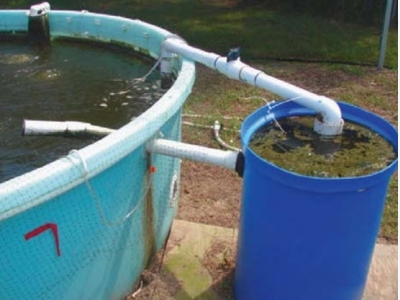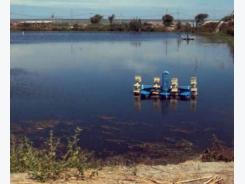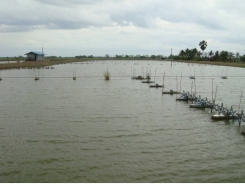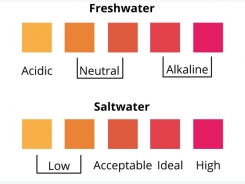Simple Settling Chambers Aid Solids Management In Biofloc System

The addition of low-cost settling chambers to culture tanks removed suspended particles and improved water quality and shrimp production.
Summary:
A study that examined the effects of removing suspended solids using side-stream settling cham-bers in a superintensive biofloc shrimp system found the chambers reduced nitrate-nitrogen and phosphate concentrations over 60% and improved shrimp growth rate and biomass by 40%. In comparing a fishmeal-based diet to a plant-based diet used in the system, few differences were noted in terms of shrimp production or water quality
Superintensive, biofloc-based culture systems have controlled feed-nutrient inputs, high stocking densities, limited or no water exchange, intense aeration or oxygenation, and an accumulation of sus-pended biofloc particles. These systems are currently used to culture shrimp and tilapia, and there is potential to use them for other animals.
This form of culture is environmen-tally sustainable due to its limited water use, which reduces discharges of potential pollutants and decreases the chance of disease transmission and interaction between wild and captive stocks. Because little water is used, and Pacific white shrimp, Litopenaeus vannamei, can be cultured in low-salinity water, this tech-nology can be implemented in arid inland areas, providing fresh marine shrimp to such locations.
Biofloc, Feeds
The biofloc particles that develop in superintensive systems are composed of uneaten feed particles, feces, detritus and microorganisms such as bacteria, algae and zooplankton. Biofloc can be ingested by the culture species, thereby recycling expensive nutrients and reducing feed costs. However, an excessive concentra-tion of particles can lead to increased bio-chemical oxygen demand, gill occlusion in culture animals, suppression of benefi-cial algal growth and promotion of potentially harmful microorganisms.
Eliminating fishmeal and fish oil from marine shrimp diets may enhance the environmental and economic sustainability of superintensive biofloc systems. The use of marine fish products in shrimp feeds may lead to over-exploitation of fisheries and potential bioaccumulation of organic contaminants. Plant-based diets could cre-ate marketing and certification opportuni-ties, and enhance profitability because plant products are generally less expensive and have more reliable production than fish-based products.
Experimental Systems
The authors recently conducted a study at the Waddell Mariculture Center in South Carolina, USA, to evaluate the effectiveness of simple, side-stream set-tling chambers at removing suspended particles from culture tanks and related effects on water quality and shrimp pro-duction. The study also compared a com-monly used commercial fishmeal-based diet to an experimental plant-based diet. The study was conducted using 16, 3.35-m-diameter outdoor polyethylene tanks. The tanks were filled with 6.25 m3 of water with a mean salinity of approxi-mately 20 ppt and aerated using air blowers and ceramic air stones. Litopenaeus vannamei shrimp were stocked when they weighed 1.31 g at a density of 460 m3 and cultured for 12 weeks.
Half of the tanks had simple, in-house-constructed settling chambers adjacent to them, and half did not. Water was airlifted to the settling chambers down a central baffle, where velocity slowed. Solids settled at the bottom of the chambers and were removed weekly. When turbidity tested periodically in the culture tanks rose above 30 nephelomet-ric turbidity units (NTU), the chambers were operated.
For tanks with or without solids removal, half received the plant-based feed and half received the fish-based feed. This created four unique treatments (plant, plant settled, fish, fish settled), each consisting of four randomly assigned replicate tanks.
The crude protein contents of the plant- and fish-based diets were 36.4 and 35.7%, respectively, and total lipid levels were 10.8 and 11.0%, respectively. The plant-based diet – whose main ingredi-ents were soybean meal, corn gluten meal, whole wheat and pea meal – did not contain fishmeal, fish oil or a binder. Both diets were prepared with an extru-sion process.
Water Quality Results
Water quality parameters for temper-ature, dissolved oxygen, pH, salinity, ammonia-nitrogen and nitrite-nitrogen all remained within ranges acceptable for L. vannamei growth. Other than phos-phate concentration, there was no signifi-cant difference in any measured water quality parameter between the two diets.
Nitrate-nitrogen concentrations were significantly decreased in the shrimp tanks with solids management, with final values of 55 mg nitrate-nitrogen/L compared to 138 mg nitrate-nitrogen/L in tanks with-out solids management – a difference of 60%.
Final phosphate concentrations were 62% lower in tanks with solids manage-ment than those without: 40 mg phosphate/L versus 105 mg phosphate /L, respectively. Phosphate levels were also significantly lower in tanks that received the plant diet than those with the fish diet, regardless of solids management: 58 mg phosphate/L versus 87 mg phosphate/L, respectively – a difference of 33%.
Turbidity, total suspended solids (TSS), and volatile suspended solids (VSS) were all significantly reduced by settling chambers (Figures 1 and 2). Overall mean turbidity was 47% lower in tanks with solids management than those without. The mean TSS concentration in tanks with solids management was 41% lower than in tanks without solids man-agement. Overall mean VSS concentra-tion was 47% lower in the tanks with sol-ids management.
Alkalinity was significantly higher in the tanks with solids management. Over-all mean alkalinity was 88 mg as calcium carbonate/L in tanks with solids manage-ment and 59 mg carbonate/L in tanks without solids management – a difference of 33%.
Shrimp Production Results
There was no significant difference in any shrimp production parameter mea-sured between the two diets.
Overall mean survival was 71% in the experiment with no significant difference in shrimp survival among the treatments. The final mean feed-conversion ratio for treatments with solids management was significantly lower than for those with-out: 2.05 versus 2.82, respectively. At 3.04 kg/m3, the final mean biomass pro-duction was 41% greater in treatments with solids management than those with-out solids management (2.16 kg/m3).
Overall mean shrimp growth rate (Figure 3) was 0.88 g/week in treatments with solids management versus 0.63 g/ week in treatments without solids man-agement, indicating that shrimp grew 40% faster with solids management.



Perspectives
Production values in this experiment were generally low, likely due to the sus-ceptibility of the small, outdoor tanks to rapid physical changes, the relatively short duration of the experiment and the relatively high density of shrimp in the small tanks. However, the conclusions are clear, and based on these findings should likely be scaled up to commercial-scale production systems.
Managing solids during this study had dramatic effects on water quality and shrimp production. By targeting a turbid-ity value of 30 NTU, system performance was significantly improved. It is interest-ing to note that neither TSS nor VSS were statistically correlated with turbid-ity. However, overall mean concentra-tions of 459 mg/L TSS and 261 mg/L VSS were maintained using the simple, low-cost settling chambers
Based on this, the authors recom-mend cropping to reduce TSS concentra-tions to approximately 460 mg/L and turbidity to about 30 NTU in superinten-sive biofloc systems to improve produc-tion. In large systems, it may be difficult to maintain such low TSS and turbidity values. However, at this point, it appears that removing a substantial quantity of suspended solids will improve water qual-ity and shrimp production.
Because nitrate-nitrogen and phos-phate concentrations were both signifi-cantly decreased, and alkalinity was sig-nificantly increased, it is possible that denitrification was occurring in the set-tling chambers. Denitrification is a highly beneficial microbial process for recirculat-ing aquaculture systems that can convert nitrate to nitrogen gas, assimilate phos-phate and generate alkalinity. Improved water quality can benefit production and allow culture water to be reused. Increased alkalinity may reduce the need for buffering compounds, thereby reduc-ing production costs.
The trial data do not explain why cropping suspended solids improved shrimp production. Hypotheses include effects related to improved water quality, enhanced microbial composition or reduced gill fouling. Clearly, with a 41% increase in shrimp biomass, this is an important area for further research.
This project demonstrated that a plant-based diet can result in shrimp pro-duction equal to that of a traditional, fish-based diet in superintensive biofloc sys-tems. The plant-based diet also resulted in less phosphate accumulation, which may be beneficial if water from these systems is to be reused for multiple culture cycles. Using a plant-based feed to culture shrimp may result in higher profitability and enhanced environmental sustainability. Shrimp cultured on vegetarian-based feeds may qualify for certification or labeling programs that add value to the end prod-uct. With increasing fishmeal prices, more attention should be paid to alternative for-mulations. By relying less on fish products for shrimp culture, the risks of bioaccumu-lation of organic contaminants and over-exploitation of marine resources are reduced
Related news
Tools

Phối trộn thức ăn chăn nuôi

Pha dung dịch thủy canh

Định mức cho tôm ăn

Phối trộn phân bón NPK

Xác định tỷ lệ tôm sống

Chuyển đổi đơn vị phân bón

Xác định công suất sục khí

Chuyển đổi đơn vị tôm

Tính diện tích nhà kính

Tính thể tích ao




 Turbidity Removal From Pond Waters
Turbidity Removal From Pond Waters  Managing High pH in Freshwater Ponds
Managing High pH in Freshwater Ponds